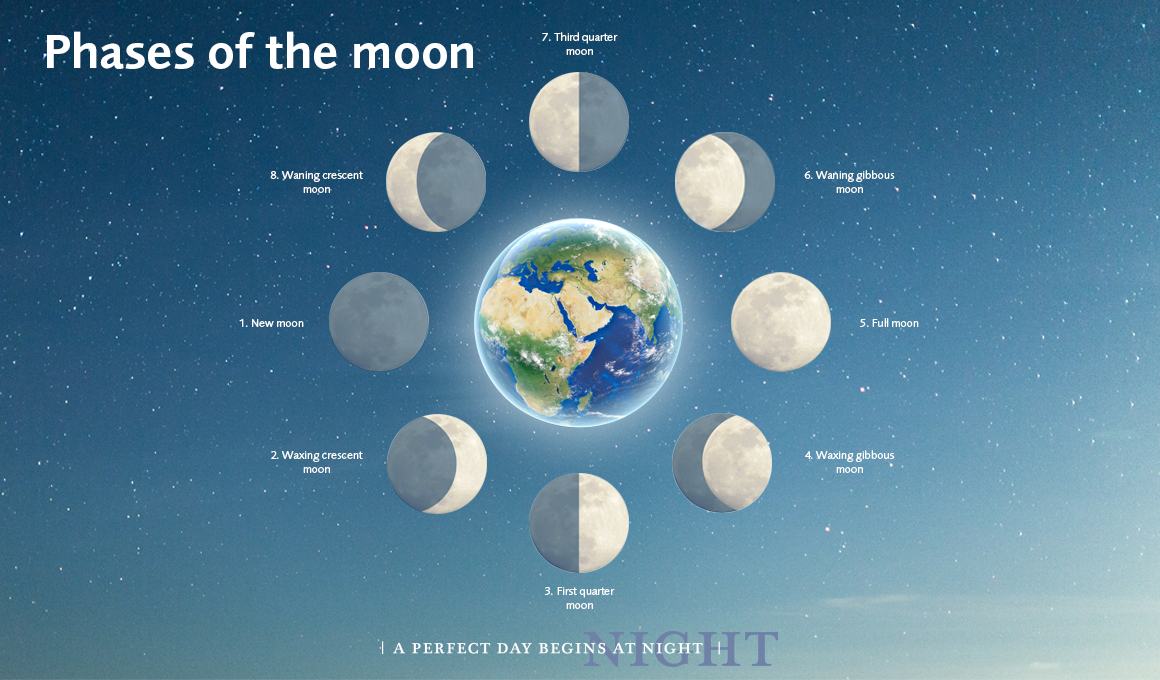Moon phases – how the moon changes over the course of its cycle
The moon is our constant companion and goes through different phases over the course of about a month. The lunar cycle lasts approximately 29.5 days. During this phase, we repeatedly perceive the moon in different ways. The appearance of the celestial body changes, sometimes it is larger, sometimes smaller, sometimes fully visible, sometimes only half visible or not visible at all. But how do these different phases of the moon come about? Which ones are there exactly? Do some of them have an influence on our sleep?
How do the different phases of the moon come about?
The different phases of the moon are caused by the interaction of the sun, earth and moon and influence the appearance of the moon in the sky. There are eight main phases of the moon, which are categorized as follows: New moon, waxing crescent moon, waxing crescent moon, waxing three-quarter moon, full moon, waning three-quarter moon, waning crescent moon and waning crescent moon. Each phase has its own characteristic features. Some are associated with special astronomical events. Some moon phases also have cultural, historical, spiritual or religious significance.
Is there a connection between the individual phases of the moon and sleep?
The moon and its various phases have always fascinated people, and there are many theories and anecdotes about the moon’s influence on sleep. Scientific studies on this provide mixed results, but here are some correlations that are often discussed:
1. Influence of sleep at new moon:
During the new moon, the sky is particularly dark as the moon is not visible. Some studies and reports suggest that the darkness may be conducive to deeper sleep, as less natural light is less disruptive to the production of melatonin, the sleep hormone.
2. Influence of sleep at full moon:
The full moon is known for its bright glow and can actually be bright enough to disrupt sleep. Scientific research has shown that people take longer to fall asleep during a full moon, have less deep sleep and record less sleep time overall. Some studies have also found lower melatonin production during the full moon.
In our blog you will also find the blog post Sleep research confirmed: Full moon influences sleep, in which we explain in more detail the influence of this particular moon phase on our sleep, among other things
- The biggest and brightest moon is the supermoon. Read our blog post to find out whether the supermoon affects our sleep.
- The lunar eclipse is a rather rare phenomenon. Find out what influence the lunar eclipse has on our sleep and everything to do with lunar eclipses in our blog post.
3. Influence of sleep during waxing and waning moon:
In the phases of the waxing and waning moon, there is less research on direct effects on sleep. However, the increasing light in the first half of the cycle and the decreasing light in the second half could have an influence on sleep behavior.
4. Psychological and cultural influences:
People’s beliefs and expectations can also play a role. If someone firmly believes that the moon influences their sleep, this could psychologically lead to a self-fulfilling prophecy.
Overall, the scientific consensus on the influence of moon phases on sleep is not clear, and more research is needed to draw definitive conclusions. It is also important to emphasize that individual sleep patterns can be influenced by many factors, including environment, health status and personal habits.
What exactly are the phases of the moon?
1st moon phase: New moon
The new moon marks the beginning of a new lunar cycle. During this phase, the moon is between the earth and the sun, so that its side facing the earth is not illuminated by the sun and therefore remains invisible. The new moon is a favorable time for stargazing as there is no moonlight illuminating the sky. Occasionally, a solar eclipse can occur during a new moon, when the moon is exactly between the sun and the earth, partially or completely blocking the sunlight.
In many cultures, the new moon was seen as a sign of a new beginning. The lunar calendar of many ancient societies began with the new moon – including the Islamic and Chinese calendars – and agricultural cycles also used to follow it.
2nd moon phase: Waxing crescent moon
After the new moon, the moon begins to emerge from the darkness. A narrow crescent becomes visible, which increases in size over the coming nights. In many cultures, this phase is associated with new beginnings and growth.
3rd moon phase: First quarter moon
The moon reaches the first quarter about a week after the new moon. The right half of the moon (as seen from the northern hemisphere) is illuminated. During this phase, the moon rises around midday and sets around midnight.
In earlier times, the waxing half moon had a special significance for sailors and farmers. They used this phase to plan their activities, as the half moon already provided enough light for night-time work.
4th moon phase: Waxing gibbous moon
In the following days, the moon continues to wax. This phase is called the waxing three-quarter moon, as more than half of the moon is visible. The moon now rises later in the evening and remains visible until the early hours of the morning.
Many ancient religions also saw this phase as a time of growth and strengthening. Rituals and ceremonies were held to pray for success and good fortune.
5th moon phase: Full moon
The full moon is the most spectacular phase of the lunar cycle. During this phase, the moon is directly opposite the sun so that its entire visible side is illuminated. The full moon can take on various forms:
- As a supermoon, it appears larger and brighter than usual.
- During a total lunar eclipse, the moon takes on a reddish color because the sunlight is scattered by the Earth’s atmosphere. It is then also called a blood moon.
- Last but not least, there is the so-called micromoon. Here the moon is at its furthest position from the earth – also known as apogee – and therefore appears smaller and less bright than usual.
6th moon phase: Waning gibbous moon
After the full moon, the moon begins to shrink again and is now called the waning three-quarter moon – or waning moon for short. During this phase, the moon rises later in the night and is visible until the early hours of the morning.
In traditional and spiritual cultures, the waning moon was seen as a time of reflection and retreat. It was often associated with harvest cycles and preparation for winter.
7th moon phase: Third quarter moon
About three weeks after the new moon, the moon reaches the last quarter and appears as a waning crescent. Now the left half of the moon is illuminated (as seen from the northern hemisphere). The moon rises at midnight and is visible until mid-morning.
8th moon phase: Waning crescent moon
The waning crescent moon is the last phase of the lunar cycle. The moon only appears as a narrow crescent in the early morning sky before it finally disappears again in the new moon. This phase is often associated with retreat, reflection and preparation for a new cycle.
After the waning crescent moon, the moon enters the phase of the new moon again and the lunar cycle begins anew.














